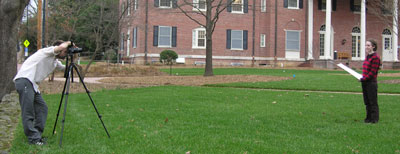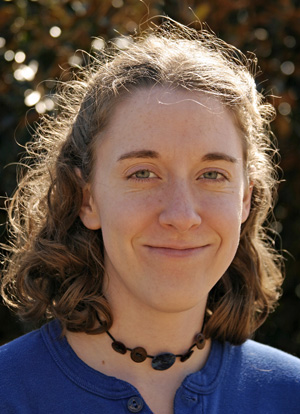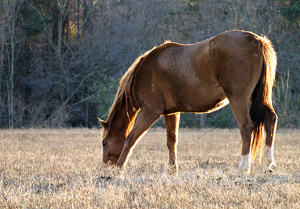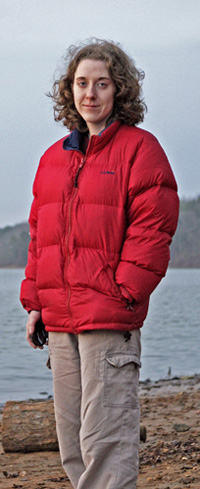AnandTech Guide to Better Photos: Portraits
by Stephen Caston on January 19, 2005 12:05 AM EST- Posted in
- Digital Camera
Outdoor Portraits
In the daylight outside, there is usually more than enough light for versatile portrait photography. One of the greatest opportunities for portraits is an overcast day. The diffusion of daylight through the clouds creates a very pleasant soft light that looks great for portraits. If there are no clouds to shoot under, look for the shade of a tree instead. The effect is similar with the sunlight filtering through the leaves. Without shade from the sun, there will likely be strong shadows and bright highlights on your subject that will be difficult to expose properly. Strong shadows tend to exaggerate noses, wrinkles, etc. - all of which your subject will not appreciate.When arranging your shot, pay close attention to the direction of light. Have your subject face in different directions while you monitor the effect. Even with diffused overcast lighting, if the light is shining down from a position above your subject, there will be some soft shadows that may not be the most flattering for your subject. To remedy this, there are two popular options: reflectors and fill flash. A reflector is simply a white or colored surface that is used to bounce light upward into the subject's face to fill in shadows. The difference in the color of the reflector simply affects the color cast on the subject. For example, if you wanted to reflect a warmer light, you could use an orange reflector. Below is an example of how a reflector can be used.

Subject at right holding reflector
In the image above, our subject held the reflector herself. If we were taking full body portraits, we would obviously need another method of holding the reflector. In the absence of assistance, a tripod and self-timer will allow you to hold the reflector for your subject. In the example below, we used a large white piece of cardboard to reflect light into shadow areas on the subject's face. You can pick up one of these inexpensive reflectors at any office supply store. However, high quality collapsible reflectors can be purchased from professional camera stores as well. Hold your mouse over the image below to see the difference.
In the above image with the reflector, notice how the major shadows under the neck, cheeks, and eyes have been filled in with soft white light. Think of a reflector as a moveable soft light source. You can change positions and angles to produce difference effects. Another option is to use the camera's flash to produce a similar effect. This is referred to as a fill flash. Fill flash essentially forces the camera to use its flash even though there is already enough light for a shot. To use a fill flash in your portrait shot, set your camera to its fill/force flash setting and take your picture as normal. You may need to move closer to your subject depending on the range of your flash. Some cameras have the option to adjust the intensity of the fill flash. Below is an example of a fill flash. Hold your mouse over the image to see the difference.
In addition to filling in shadow areas, a fill flash also adds a "catch light" in the subject's eyes. This helps direct the viewer's attention and gives the eyes a special emphasis. In the latest version of Adobe Photoshop, you can even fill in some of these shadows later on during post processing. In Photoshop CS, there is an option under the Adjustments menu called "Shadow/Highlight". In the comparison below, the original image was taken without the use of a reflector or fill flash. In the rollover image, we specified 40% under the Shadow section of the popup dialog box. Hold your mouse over the original image to see the effect of the Shadow/Highlight feature in Photoshop CS.
Look for interesting lighting when you are shooting outside. For example, when the sun is behind your subject, a "halo" effect can be achieved from the backlighting. In the example below, we took a picture of our subject with the sun behind her.

The effect is a warm highlight along the edges of the hair. In the picture above, we used a whiteboard to reflect light back to the subject's face to fill in some shadows. One of the problems that you will run into when shooting into the sun is that the camera will most likely underexpose the image. To avoid this, you should try setting your camera to spot metering. When set to spot metering, the camera will meter the light from a small point instead of the whole frame. Another option when working with backlighting is to apply an E.C. (exposure compensation). E.C. can be applied to force the camera to expose the image more or less than it normally would. When a camera is pointed at a bright scene, it will typically underexpose the subject. If this is the case, try applying a positive E.C. Check the results and adjust the E.C. until the picture looks well-exposed.

 |
 |

With these basic portrait ideas, you should have no problem producing great looking portraits with little effort. Remember to experiment with different shooting angles and subject positions. Pay attention to the quality of light. If it is too harsh or strong shadows appear, use a fill flash or reflector. For outdoor shooting, there is no excuse for not getting a reflector. They are inexpensive and will enhance your overall portrait quality. The more pictures you take, the more you will learn what works and what doesn't. In our next guide, we are going to explore the possibilities of night pictures. In the meantime, start taking more pictures of your friends and family. Pay attention to your technique and analyze the results. Before you know it, people will be begging you to take their picture!












30 Comments
View All Comments
krismar - Tuesday, December 4, 2007 - link
Tips and techniques from HP Digital Photography to improve your digital photos and make them stand out in your photo album.http://www.hp.com/united-states/consumer/digital_p...">http://www.hp.com/united-states/consume...tography...
thehorriblejoke - Friday, October 15, 2010 - link
this is not spam http://www.youtube.com/thehorriblejokekappy - Thursday, February 10, 2005 - link
There's one simple thing that I feel was missed. I am always handing off my camera for a potrait, and when I finally see the picture, my head is in the absolute middle of the frame. Above is a huge, boring gap, and I am cut off at the torso. Beginners don't realize that in daily life, their eyes are naturally drawn to faces, and this carries over into putting faces in the center of their photographic compositions. This, to me, is the #1 no-no of portrait photography. Use the Rule of Thirds or something interesting instead.michael2k - Tuesday, January 25, 2005 - link
But without pictures, what's the point of a photo video player?thehorriblejoke - Friday, October 15, 2010 - link
trueshuttleboi - Sunday, January 23, 2005 - link
Hey AnandTech photo writers: how about fewer articles wasting our time like this one and more tech-related photography articles (tech articles at Anandtech, go figure), like reviewing photo video players like the Epson P-2000?Jedi2155 - Saturday, January 22, 2005 - link
But I think its always nice that they occasionally have stuff like this, just ignore the article if you don't like it.I personally love hte article for something this useful for the noobs like me!
Zak - Friday, January 21, 2005 - link
Honestly, I don't come to Anandtech as much as I used to because of articles like this. Don't get me wrong, great work but that's not why I come to Anandtech for. If I want digital photo and cameras articles or Mac realated stuff I go somewhere else. Then you have the useless reviews of butt agly cases. I think you guys are losing focus. It's just my 2 cents.Zak
AtaStrumf - Friday, January 21, 2005 - link
Just because I see some people sill dont' get it, DOF is indeed affected by all three variables mentioned above. Just a minor correction. The size of the senzor (film format) itself does not affect DOF, it's the relative focal length that's to blame. e.g. a 4x zoom digital camera specs migth say 35 - 140 mm, but it's actually a 7,2 - 28,8 mm in 35mm film (leica) format terms - conversion factor depends on the difference between CCD sensor size and classic 24x36 mm film size. That explains the huge DOF in digital cameras.Anyway a nice little article. I especially liked that nifty Photoshop trick. Keep them comming.
kcma - Friday, January 21, 2005 - link
#17 try shooting with 400mm lens at f16, and 14mm lens at f2, come back here and say that again ;) better yeh, take a fisheye and see if you can throw anything out of focus.***
also, the size of sensor affects depth of field. that's why with medium format/4x5/8x10 camera, it's very easy to blur things out. and for the longest time, it's impossible to throw things out of focus with digital camera.
and last... OH NO!! the secret's out, dont use on camera flash and you're picture won't look HORRIBLE!! i'll be outta job soon... ppl won't need photographers anymore... but seriously... unless you know what you're doing, on camera flash just mess everything up. they are great for filling in shadows in daylight and some other things... but not great as the only source of light. i shoot in blackness and concerts without them. and top of the line SLRs don't have them.